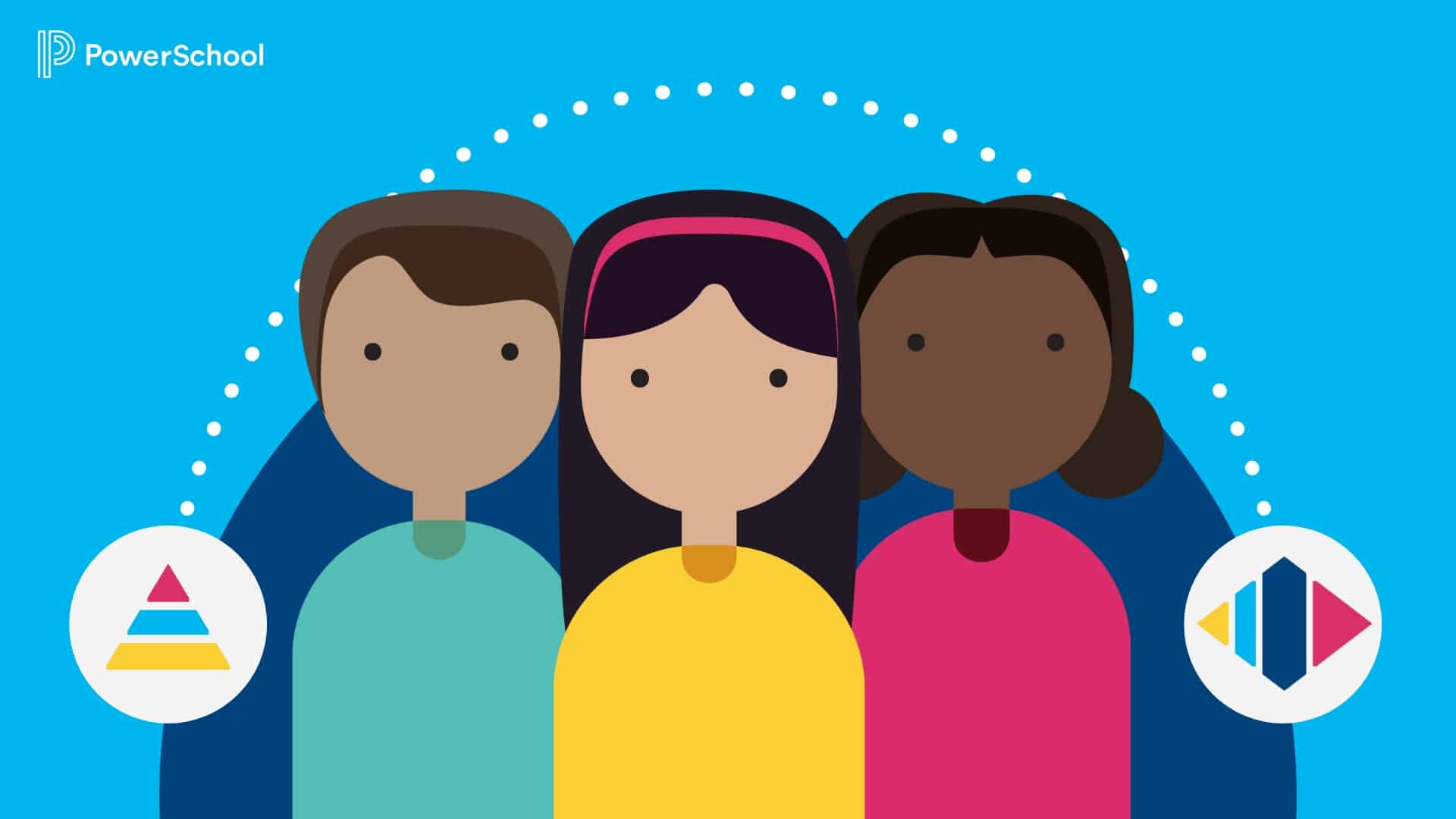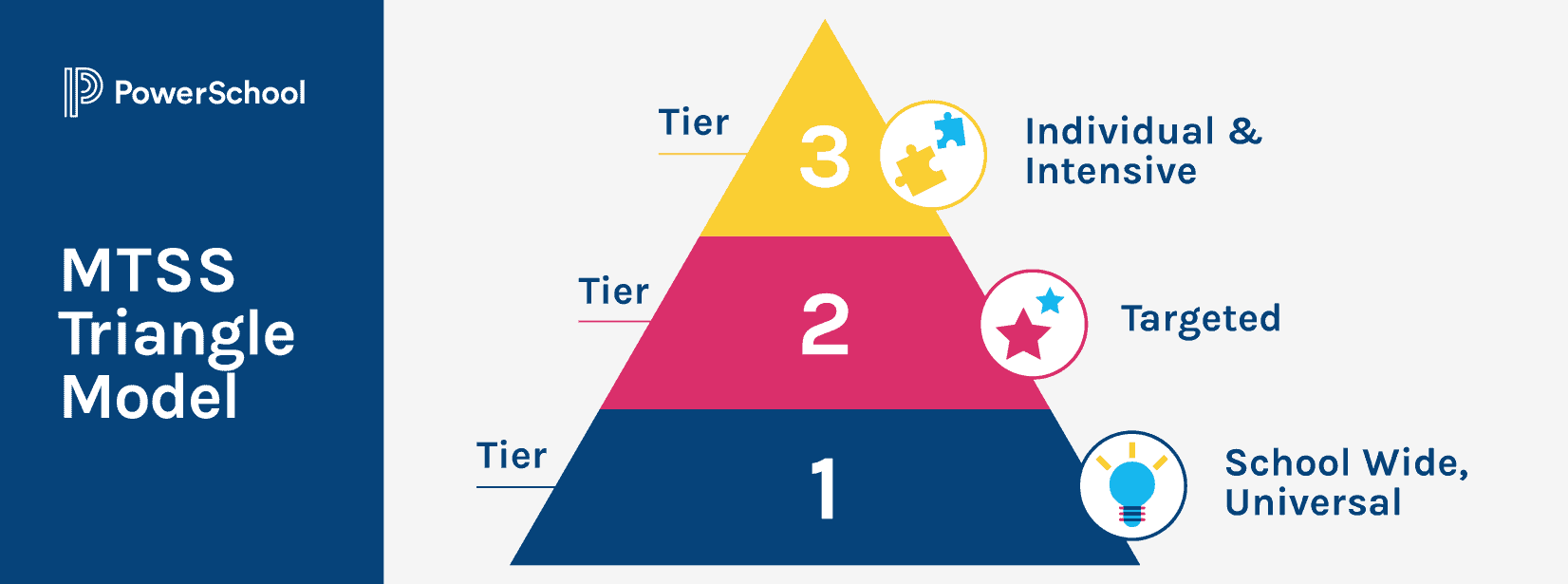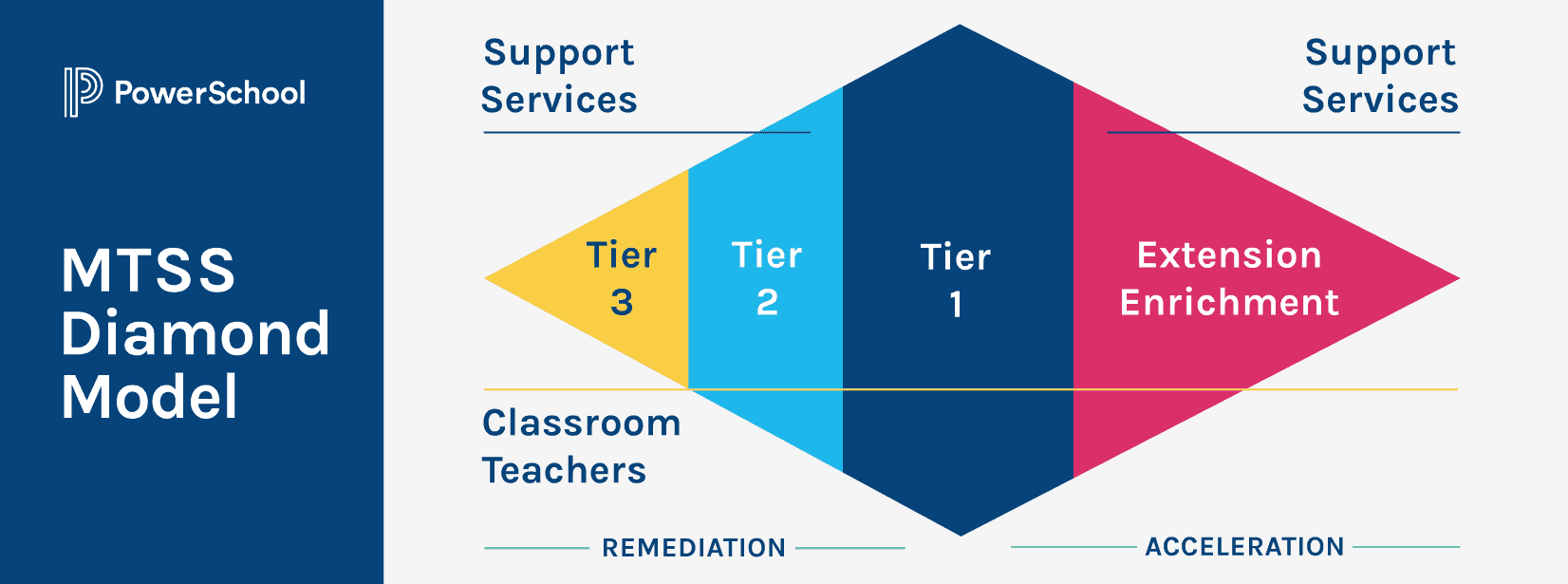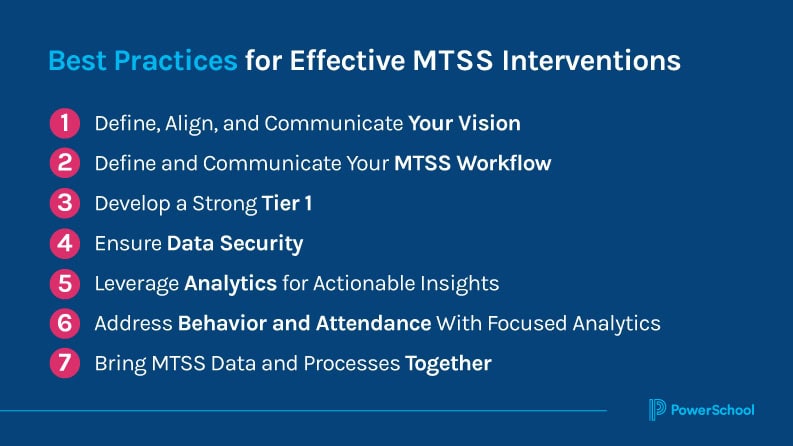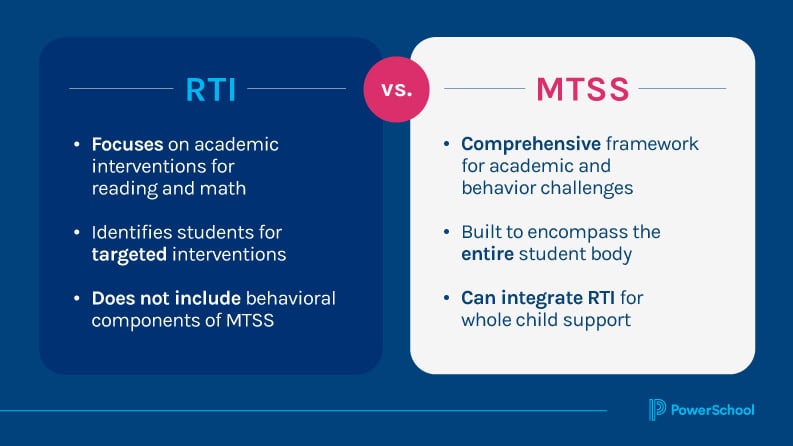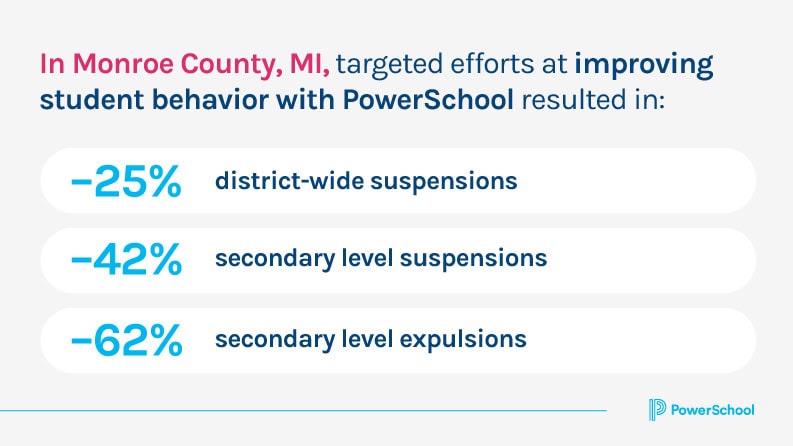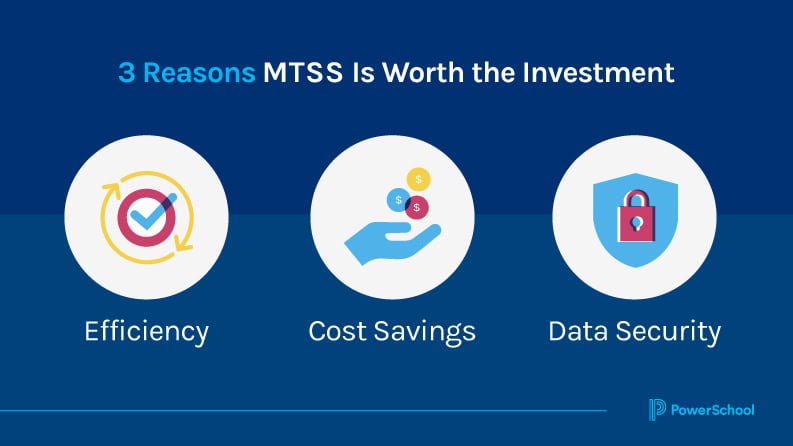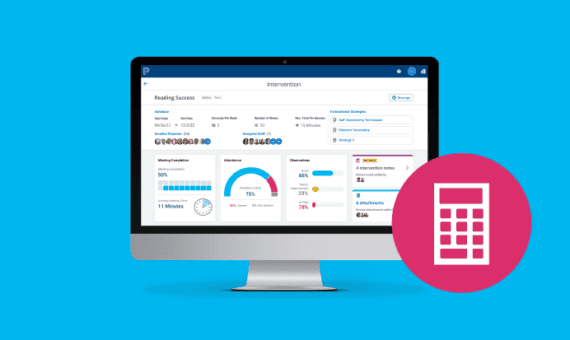What is MTSS?
Multi-Tiered Systems of Support (MTSS) can be defined as a preventative and proactive framework that relies on data to meet the needs of each student. It provides a tiered infrastructure of increasingly intensified instructional and social and emotional behavior supports.
This post explores the fundamentals of MTSS and how MTSS can be used to meet holistic student needs, from academics to attendance to behavior and social and emotional learning (SEL).
What are the essential components of MTSS?
At its core, MTSS seamlessly merges data with instruction to enhance student achievement while supporting students’ social, emotional, and behavioral needs. It’s a blueprint that guides educators to make data-driven decisions, streamline high-quality instruction, and bolster positive behavioral supports. This proactive approach identifies challenges early on.
Here are the four core elements of MTSS:
1. MTSS Screening
Think of screening as a quick health check for all students. Done three times a year, it helps spot students who might need extra help, whether in academics, behavior, or emotional well-being. It’s sensitive to different backgrounds, ensuring every student is fairly evaluated.
2. Multi-Level Prevention System
Like a set of building blocks, MTSS has three levels:
- Tier 1: A foundational level for all, setting a positive base for learning and behavior.
- Tier 2: Offers targeted group support for those who need it.
- Tier 3: The most personalized for students needing intensive assistance.
At each tier, practices are selected based on proven effectiveness, ensuring students get what they need.
3. MTSS Monitoring
Just as a coach tracks an athlete’s performance, MTSS tracks student progress. Educators can monitor students ‘ progress with reliable tools and a consistent approach and adjust support as needed.
4. MTSS and Data-Based Decision Making
MTSS relies heavily on data. It’s the compass that guides decisions, ensuring that actions taken, whether instructional changes or support systems, are backed by real insights.

Learn best practices for overcoming common challenges and finding solutions for MTSS interventions that help students succeed. Download The Guide to Effective MTSS Interventions in K-12 Education.
10 Benefits of MTSS
MTSS isn’t just a strategy—it’s a commitment to every student’s success. The multi-faceted approach offers many benefits that cater to diverse needs, ensuring no student is left behind.
- Proactive Approach: MTSS spots potential challenges early, helping prevent more significant issues.
- Data-Driven: Decisions in MTSS are backed by solid evidence, ensuring that every step is well-informed.
- Tailored Support: Each student’s unique needs are met thanks to MTSS’s adaptability.
- Early Identification: The timely and consistent checks help identify any learning or behavioral issues early.
- Positive Behavior: MTSS encourages a conducive and positive learning environment by setting clear expectations.
- Equitable Support: MTSS ensures every student gets consistent support regardless of background.
- Improved Outcomes: Students under MTSS consistently achieve better, both academically and emotionally.
- Staying Ahead: MTSS’s regular check-ins mean potential challenges are identified and tackled promptly.
- Holistic Approach: MTSS looks at the whole picture—academic, emotional, and behavioral aspects of a student.
- Dynamic Framework: MTSS adapts and evolves, always aligned with students’ changing needs.
What Is the MTSS Tiered Triangle Framework?
The three-tiered approach is the foundation of MTSS. It’s structured as a triangle of support:
Tier 1
This is the foundational level. It’s all about offering quality universal school-wide instruction and support. The goal is to create a solid learning base and positive behavior for everyone.
Tier 2
For students who need more than just foundational support, Tier 2 helps. Here, targeted group sessions address specific challenges, ensuring students get the extra care they require.
Tier 3
Tier 3 is the most specialized. If a student needs personalized, intense support, this tier ensures they get it. It’s about making sure no one is left behind.
While the triangle is more widely adopted, the diamond continues to gain momentum. Each has its advantages, and both can prove effective when correctly implemented.
What Is the MTSS Diamond Framework?
We increasingly see a newer diamond model emerging, which extends to learners on the other end of the spectrum—those needing advanced learning or acceleration. Although we understand that MTSS is for all students, many are surprised to learn that MTSS can be a robust framework to support students with advanced learning needs. It can also help students catch up academically.
The diamond model encourages a more strengths-based approach. A student needing Tier 2 support on the behavior side may also need better academic engagement and acceleration. One common reason for “acting out” is boredom. This model may help educators better differentiate instruction to ensure students stay challenged.
Key Components of an Intervention Plan
An intervention plan is a structured approach that educators utilize to address and support the specific needs of individual students. It is a comprehensive tool that details the goals, tracking mechanisms, and tailored strategies for each student’s success.
The three key components of an intervention plan are:
- Goals: Clear, achievable targets are essential.
- Progress Monitoring: Continually tracking how the journey is going ensures that students are on the right path and making the necessary progress.
- Interventions: These are the specific strategies to achieve the goals. Whether it’s a new teaching method or a specialized support tool, it’s all about what will most effectively help the student.
Example of MTSS
Here’s how an MTSS Tiered Triangle framework might be applied in a school, with the goal of every student being a fluent reader:
Tier 1 (Universal Support): All students receive high-quality, evidence-based reading instruction in their ELA class. Teachers use a standardized curriculum that is designed to meet the needs of most students. They regularly assess students’ reading abilities to identify those who may need additional support.
Tier 2 (Targeted Support): Students identified by their teachers as needing more help than is offered in Tier 1 receive more reading support. This might include smaller group instruction with more frequent progress monitoring. The interventions are targeted, meaning they focus on specific skills such as phonemic awareness or comprehension. Tier 2 students continue to receive high-quality, evidence-based reading instruction in their ELA class, too.
Tier 3 (Intensive Support): Students with significant needs—those not making progress in Tier 2—move into Tier 3, the “top” of the MTSS triangle. This level of support is the most intensive and individualized. It likely includes one-on-one instruction or specialized programs designed to address reading difficulties. The efficacy of these interventions is closely monitored, and progress is assessed regularly to ensure student improvement. As students begin to meet expected benchmarks, they may move from Tier 3 to Tier 2 with continued monitoring.
There are three essential components of MTSS in this example:
- Data-driven decision making. Regular assessments and progress monitoring help to identify students’ needs and the effectiveness of interventions.
- Layered support. Students receive support at varying levels of intensity based on their individual needs.
- Collaboration. Teachers, administrators, and specialists all work together to develop and implement interventions, ensuring that students receive the appropriate amount of support.
The MTSS framework is flexible and can be applied to any subject (math, science, history, etc.) or behavior (attendance, class disruption, etc.). The goal is to ensure that every student is at the right tier to best support their development.
Best Practices for Effective MTSS Interventions
Effective implementation of MTSS interventions in K-12 education requires careful planning, collaboration, and a commitment to continuous improvement. By following these best practices, educators can create a responsive and supportive system that addresses the diverse needs of all students.
1. Define, Align, and Communicate Your Vision
Your school or district should articulate a clear and compelling vision for MTSS that includes a preventative, proactive framework to support success for all students and a framework that all staff can align to (not just interventionists or specialists). Create a common language and guiding principles to define your ultimate vision.
2. Define and Communicate Your MTSS Workflow
Clearly defined and known processes are required for systemic coherence and excellence. Additionally, your staff needs a plan for training and resources, ensuring they feel supported and equipped to implement an MTSS process. For example, how will high school juniors be screened to ensure they are on track to graduate?
3. Develop a Strong Tier 1
Traditionally, districts should aim to see 5-15% of students in Tier 2 interventions and 1-5% in Tier 3 interventions. But in many cases, there are higher percentages at the Tier 2 and Tier 3 levels. This is problematic for several reasons. First, most districts simply do not have the resource capacity to support that many interventions. But, perhaps even more critically, an overwhelmed Tier 2 and Tier 3 system indicates that more time and attention is needed to support the instructional core within Tier 1. Use accurate, real-time data from assessments and screenings to implement early interventions and strong core instruction.
4. Ensure Data Security
Often in MTSS practices, data is stored and shared in multiple, possibly unsecure formats such as email, Google Sheets, Word documents, and unsecure devices. A modern, consolidated MTSS framework provides better data security.
5. Leverage Analytics for Actionable Insights
District leaders, chief academic officers (CAOs), superintendents, school board members, school and classroom leaders, and parents want to know if MTSS investments are making a difference. They need to know which interventions are working and which students they’re helping. Investing in a solution such as PowerSchool MTSS allows educators at all levels (teacher to superintendent) to view the intervention data they need.
6. Address Behavior and Attendance With Focused Analytics
Schools continue to struggle with behavior and attendance challenges that emerged from the pandemic. Rather than focusing on discipline, try taking a positive approach to behavior and attendance. Reward and reinforce positive behaviors through individual and group reward systems and centralize that data in one place to glean critical analytical insights. Do the same with attendance data to identify and reduce barriers that prevent students from attending school.
7. Bring MTSS Data and Processes Together
Educators often jump from system to system, spreadsheet to spreadsheet, and form to form to complete the entire MTSS process. Universal screeners, diagnostic assessments, intervention plans, progress monitoring forms, progress monitoring trackers, and intervention templates are just a few of the tools within MTSS—all potentially located in different systems. Adopting technology that brings coherence to your MTSS workflow saves educators valuable time.
Does MTSS Include Behavior?
MTSS, a comprehensive and data-driven approach, covers academic and non-academic factors, including behavior. MTSS aims to meet all students’ needs, including addressing behavioral challenges that may hinder academic success. The behavioral component of MTSS typically involves evidence-based interventions and supports to promote positive behavior, SEL, and mental health.
By incorporating behavior data into MTSS decision-making processes, districts can better support students and encourage positive behavior.
How To Incorporate Behavior Data Into MTSS
Incorporating behavioral data into your MTSS involves several steps. Start with a system for collecting and tracking behavioral data.
Districts benefit from a single, evidence-based solution that collects, tracks, analyzes, and acts upon all types of student behavior data, including historical information essential for MTSS. Many educators rely on disparate, homemade systems with inadequate data analysis tools and no school-wide tracking and communication capabilities. But, without knowing when an incident is recorded, teachers can struggle to determine the appropriate next steps.
Using PowerSchool Behavior Support, educators only have to enter incidents in one place, making it easy to identify trends, patterns, and potential behavioral issues using the embedded tools. With one place to collaborate and easily access important student information, this solution helps teachers spot students needing additional support or interventions quickly.
PBIS, RTI, and Attendance Interventions in an MTSS Framework
PBIS (Positive Behavioral Interventions and Supports), RTI (Response to Intervention), and attendance interventions live under the MTSS umbrella by addressing behavioral, academic, and attendance challenges across different tiers of support.
PBIS is a component of MTSS that provides a specific framework for addressing behavior-related aspects of student support within the broader MTSS framework. MTSS encompasses a more comprehensive approach that includes academic (RTI), behavioral, and social and emotional support, while PBIS focuses on creating a positive behavior support system.
What is the difference between MTSS and PBIS?
Positive behavioral interventions and supports (PBIS) and MTSS work together to support student success. PBIS is a proactive approach to establishing the necessary behavioral supports for students to excel socially, emotionally, and academically. PBIS is a school framework promoting expected behaviors. Like MTSS, it also uses a three-tiered system:
- Tier 1 – Universal Supports: Supports a positive environment for all, curbing challenging behaviors
- Tier 2 – Targeted Supports: Helps realign behavior using targeted, small-group strategies for students who need it
- Tier 3 – Intensive Supports: Specialized and intensive support is provided for students with severe behavioral challenges
Think of PBIS as a component of MTSS that specifically addresses behavior. While MTSS provides a broader framework for supporting students academically and non-academically, PBIS fits within this structure to offer a systematic approach to teaching positive behavior.
PBIS tiers in MTSS
PBIS operates within the MTSS framework by addressing the behavioral needs of students across all tiers. In Tier 1, PBIS includes creating clear behavior expectations, teaching SEL skills, and implementing systems for acknowledging and reinforcing positive behaviors for all students. In Tier 2, PBIS provides small-group social skills training, mentoring, and check-in/check-out systems to address specific behavioral challenges. In Tier 3, PBIS provides individualized interventions for students with significant behavioral challenges, such as functional behavior assessments and behavior intervention plans.
RTI tiers in MTSS
RTI aligns with MTSS to address academic challenges. In Tier 1, regular assessments are conducted to identify students needing additional support. In Tier 2, students not making sufficient progress receive targeted interventions, often in small groups, to address specific skill gaps. In Tier 3, students who continue to struggle receive intensive interventions that are more individualized and focused on their particular needs.
Attendance Interventions in MTSS
Attendance interventions are an integral part of MTSS. In Tier 1, schools work to promote regular attendance by improving school culture and creating incentives. In Tier 2, students with attendance challenges participate in interventions such as mentorship, counseling, and incentives. Focusing on two-way communication, which could include sending digital postcards to the home, is another example of a Tier 2 intervention. In Tier 3, schools implement individualized interventions for chronically absent students. An example is providing housing stability supports for families.
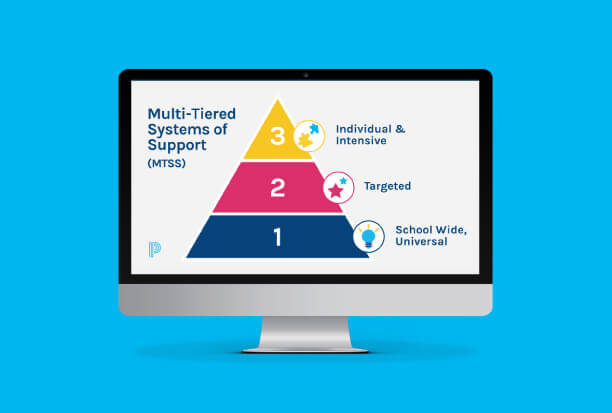
Increase the impact of your PBIS, RTI, mental health, and attendance programs by building on the foundational framework of MTSS. Watch this on-demand webinar to discover best practices and strategies for implementing data-driven MTSS.
Differences Between RTI and MTSS
MTSS is a broad, comprehensive framework that can intensify support for both academic and behavior challenges. It integrates elements of RTI but also addresses social, emotional, and behavioral needs, adopting a whole child approach to student support.
In contrast, RTI focuses primarily on academic interventions, particularly for reading and math. It helps identify students who are struggling academically and provides targeted instruction to boost their success.
Additionally, MTSS is built to encompass the entire student body. Its first tier provides universal behavior and academic support for all students, such as school-wide behavior expectations and classroom norms. Alternatively, the first tier of RTI acts as an academic “screening” for students, identifying students who will need targeted or individualized interventions. RTI also helps teachers and specialists determine if students qualify for special education services.
Principally, MTSS may integrate RTI into its broader framework to provide more comprehensive support to the whole child. RTI is much more narrowly focused and doesn’t include the behavioral and social and emotional components of MTSS.
How MTSS Supports Mental Health in K-12
MTSS is a powerful framework for schools and educators to support students’ academic, behavioral, and developmental needs. Using a data-driven, tiered approach, MTSS ensures that each student receives the appropriate support, whether that support is universal, targeted, or intensive.
MTSS aligns with the principles of early intervention and prevention used in the medical field, including public health and pediatric care. It’s not surprising, then, that MTSS can be such a powerful framework for more effectively identifying and supporting students who need mental health support.
Schools play a critical role in connecting students with the help they need. Because students spend many of their waking hours at school, school staff have the unique opportunity to intervene early. In fact, the National Alliance on Mental Illness (NAMI) reports that students are nearly just as likely to receive mental health services in an educational setting as they are to receive those services from a mental health provider (15% compared to 17%).
Early intervention can help prevent the escalation of symptoms and guide a student back onto a positive developmental trajectory. It also mitigates the likelihood of students finding themselves in a mental health crisis and is more cost-effective than delaying treatment until more intensive support is required.
Why MTSS Interventions Matter for Students
Coming out of the COVID-19 pandemic—when students’ everyday activities, methods of learning, and social interactions were turned upside down—it’s clear that they haven’t caught back up yet. Students need additional support.
Fully implemented MTSS can have a significant impact on academic and behavioral outcomes. According to research from the University of Nebraska:
- Schools implementing MTSS have 30% fewer suspension incidents and 5% fewer behavioral referrals than non-MTSS schools
- In 500+ schools in Kansas, schools participating in MTSS training were moving toward higher stages of implementation and showed increased proficiency in state assessments, decreases in office discipline referrals, and decreases in special education referrals
- In Florida, elementary, middle, and high schools participating in MTSS Tier 1 interventions saw a 33% reduction in office discipline referrals (ODRs), a 16% reduction in days of in-school suspension, and an increase in the average percentage of students scoring Level 3 or higher in reading.
In Monroe County, MI, targeted efforts at improving student behavior reduced district-wide suspensions by 25%. At the secondary level, suspensions were reduced by 42% and expulsions by 62%. By intentionally implementing and monitoring a behavior points system within their MTSS framework, educators saw visible improvement in the kindness and positivity of the student body.
Choosing an MTSS Solution
Choosing the right MTSS technology solution is crucial for effectively implementing and managing the framework in your school or district. Follow these steps to make the most informed decision:
- Identify your needs and goals. Evaluate what systems you already have in place and identify gaps or inefficiencies. Are you looking for a solution that integrates academic and behavioral data? Do you need better data visualization tools? Then, clearly define your goals. Are you aiming to improve data collection, streamline intervention tracking, enhance communication among staff, or all of the above?
- Consider the key features you need and list them in order of priority. Your list may contain features such as data integration, tiered support management, progress monitoring, customizability, user experience, and collaboration tools.
- Evaluate vendors, training, and ongoing support. Ask vendors if they supply comprehensive training for your staff, not just during the initial rollout but on an ongoing basis as needed. Look for a vendor with strong customer support, including availability, response time, and quick problem resolution. Understand the full cost of partnering with the vendor and check that they comply with data protection regulations and education standards. After thoroughly researching and comparing options, create a clear implementation plan to ensure the transition to the system is as smooth as possible.
How an MTSS Solution Can Improve Data Security
Your MTSS framework depends on data from multiple sources and systems to see the whole child. Protecting all that data throughout the process is challenging—and essential.
Data breaches compromise student data, resulting in privacy violations, personal information exposure, potential fraud, reputational damage, and legal and financial repercussions, among other consequences.
A modern, unified MTSS framework provides better security by centralizing data in one tool that identifies and tracks student needs. A single secure system provides role-based access controls, end-to-end encryption, fully encrypted storage, full auditing, and full data recovery. It also streamlines the MTSS workflow and helps ensure that feedback loops are closed.

MTSS Infographic
Check out this infographic to find out how your data may be at risk—and how one secure, consolidated MTSS platform can better protect your highly sensitive student information.
Download the Infographic3 Reasons MTSS Is Worth the Investment
Time spent inefficiently is a waste of money. Time spent executing your MTSS framework is no exception. Educators often jump from system to system, spreadsheet to spreadsheet, and form to form to complete the entire MTSS process. As educators navigate between and within these items, they waste precious time that could otherwise be directed toward supporting students. The chaos of “system jumping” impacts implementation fidelity and ultimately student outcomes. But it also has a financial consequence. Here are three reasons why MTSS educational technology is a worthy investment:
1. Efficiency
MTSS educational technology is a time saver. Think about these questions. For each interventionist or teacher:
- How much time do they spend locating and then reviewing multiple data sources, including screener, formative, and summative assessments across different data domains? (ex: academics, attendance, behavior, SEL)
- How much time do they spend understanding if a student is at risk of falling behind and determining what support is needed?
- How much time is spent progress monitoring, including inputting data, taking notes, and collecting information throughout interventions?
- How much time is spent collecting and sharing data to support collaborative problem-solving meetings?
- How much time is spent reporting outcomes to school leaders and district leaders?
- How much time is spent understanding if interventions are working and for whom?
Each one of these steps is vital to the MTSS process. Each one takes time. But if they occur in a unified platform, it simplifies the entire process while benefiting students. For example, imagine that MTSS educational technology results in a mere 30% reduction in time spent for teachers. Depending on the size of your district, this alone could result in cost savings greater than six figures per year.
2. Cost Savings
Districts may also find that they pay separate licensing fees for software tools that only perform one MTSS function within your multi-faceted MTSS framework. By consolidating isolated tools into a unified platform, districts can save further. And it goes without saying that MTSS educational technology can help you understand what works. If your district is investing in an after-school tutoring program and results are non-existent with a given provider, perhaps it’s time to exit the program. This too leads to a more efficient and effective use of resources.
3. Data Security
Lastly, investing in modernized systems that provide improved data security is a critical aspect of maximizing financial ROI. Data breaches and compliance violations can result in significant financial losses, including legal fees, reputational damage, and potential loss of funding. Much of MTSS data lives precariously in unprotected spreadsheets containing highly sensitive student information. There is almost nothing stopping an email from being forwarded containing this information. By proactively addressing security vulnerabilities, districts can mitigate these risks and protect their financial and reputational interests, not to mention the rights of students.
How Does Data Analytics Help MTSS?
Data is used in so many ways with MTSS that it’s essentially ubiquitous—or everywhere and in everything. First, data screens students. If a student appears to need additional support based on the screener’s results, then additional data are reviewed to determine the root cause.
Attendance, additional assessments, office discipline referrals, and SEL surveys are just a few examples of some of the data analyzed. From there, a student is assigned an intervention. Yet again, data are required. This time data monitors the progress of the intervention. Ultimately the teacher or interventionist needs to understand if the intervention worked or didn’t, and why.
All this data is used for just one student. What happens when an entire district implements and invests in MTSS? This is a reality across the U.S. The 2023 Education Focus Report shows that increasing tiered support practices is an expanding district strategic priority area.
Also according to the 2023 Education Focus Report survey results, only 4 in 10 educators can partially say which interventions are working, based on some data collected. Just 2 in 10 say they “absolutely” know what works and have the data to back it up.
District leaders, CAOs, superintendents, and school board members want to know if MTSS investments are making a difference. They need to know which interventions are working and which students they’re helping.

Funding Tips for K-12 Data Analytics and MTSS Solutions
Read the blog for tips on maximizing your funding and making the case for MTSS technology.
Read the BlogUnfortunately, most districts don’t have data systems that can support this type of questioning and analysis. In fact, most district leaders, like CAOs and Superintendents, can’t answer the most fundamental questions, like, “What interventions do we assign? For which students? At which schools?” When you can’t answer these basic questions, it’s impossible to understand what’s working.
These challenges arise because most districts don’t have data systems that can collect and aggregate intervention information. Even for the few that do, many districts don’t have data systems that can deliver this information back to them in the form of insightful intervention analytics.
This means that the people accountable for improving student outcomes are operating in a black hole. While they can see student outcomes like standardized test scores, they can’t see the assigned interventions that led to these outcomes. Educators deserve better.
Technology is well positioned to solve certain challenges, and PowerSchool MTSS is one of those technology products. It allows the entire MTSS workflow to be housed in one solution.
Completing the MTSS process often requires educators to switch between multiple systems, losing valuable time to procedure and process. MTSS technology can contribute to the financial return on investment through efficiency gains.
Educators can review a holistic set of data (academic, behavior, attendance, and SEL) in one place. They can select the appropriate intervention based on student needs and monitor the intervention’s progress in real-time. This by itself is a game changer as most educators are forced to use multiple “systems” just to support what has been described so far.
But when it comes to intervention analytics, PowerSchool MTSS allows educators at all levels (teacher to superintendent) to view the intervention data they need. For teachers, this means understanding whether a student or group of students has made progress on an assigned intervention. For a superintendent, it might mean understanding which interventions were completed with a successful outcome—by grade level and demographics across the entire district. This information can help district leaders tailor professional learning efforts around specific interventions or inform resource allocation decisions.
Superintendents, CAOs, MTSS leaders, principals, and teachers should all have the data to understand whether interventions make students more successful. Currently, many educators simply lack visibility into intervention efficacy. But it does not need to be this way anymore.
Moving MTSS Forward With Deeper, More Connected Data
By integrating behavior and attendance into your MTSS, you can ensure a well-rounded approach to student support that addresses academic and behavioral needs. This integration can contribute to increased student engagement and improved academic outcomes.
Whether your district uses the Diamond model or the Triangle model, PowerSchool can help you enhance your MTSS practice. PowerSchool MTSS provides educators with one secure tool to establish personalized student plans and equip intervention teams with critical data to identify student needs, assign and monitor interventions, and track progress toward goals. This approach helps you meet students where they are and provide the support they need.
How PowerSchool MTSS Meets Critical Student Needs
Today’s technologies allow the entire MTSS workflow to be housed in one software solution. One comprehensive platform empowers educators to review a holistic data set in one convenient place.
Educators can select the appropriate intervention based on student needs and then monitor the student’s progress in real time. District staff can see which schools assign specific interventions and also see the results. This can help tailor professional learning efforts or inform resource allocation decisions.
As part of the PowerSchool Student Success Cloud, PowerSchool MTSS gives educators a comprehensive MTSS product combined with student analytics, attendance, and behavior support in one complete system.
With the right MTSS tools and processes, educators can create a responsive and supportive environment that supports each student along their journey.
Explore the Student Success Cloud
Only PowerSchool’s Student Success Cloud provides the complete support students need for future success—from addressing chronic absenteeism to promoting positive behavior to comprehensive multi-tiered systems of support (MTSS).
Learn More